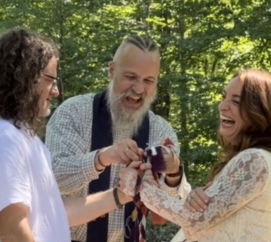One of the first weddings I performed included a handfasting, which brought my life in a full circle: my first serious romantic relationship was solemnized with a handfasting instead of marriage. Handfasting is a ceremony with deep Celtic roots that involves wrapping the hands of the couple together with a cord to show that they are united. There’s a special technique that’s used, which when done properly allows each of the couple to grasp and end of the cord and “tie the knot” as they pull their hands apart.
During the handfasting itself, I’ll say something along these lines:

As your hands are now bound together, so your lives are joined in a union of love and trust.
The eternity knot of this binding symbolizes the vows you have made.
Like the stars, your love should be a constant source of light, and like the earth, a fine foundation on which to grow.
May this knot of love remain forever tied, and may these hands be blessed.
May they always hold one another.
May they have the strength to hold on tightly during the storms of life.
May they remain tender and gentle as they nurture each other.
Handfasting seems to have very old roots as a tradition to join lives, perhaps older than the traditional American wedding. Some couples choose to replace an exchange of rings with a handfasting, while others want to include both of these unity ceremonies in their own custom wedding. During a workshop session, I help my clients decide what unity ceremonies are going to be the most meaningful for symbolize this commitment to one another.
This form of tying the knot can also be used as a commitment ceremony on its own; this is perfect for adults who want an open acknowledgement of their shared lives without necessarily making the legal commitment of marriage right now, such as for at the beginning of an engagement, or when the relationship involves more than two individuals.
